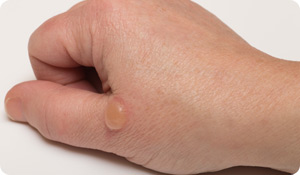
Infections from staphyloccus bacteria are common and usually minor, but they spread easily and, if left untreated, can cause serious health problems.
Staph Bacteria and the Most Common Kinds of Staph Infections
There are many different strains of staphyloccus bacteria, but staphylococcus aureus (staph aureus) is the most common. Staph aureus live on the skin and in the nose—even in healthy individuals.
Staph in the Skin. Staph can cause an infection when a cut, wound, blister, or even a hair follicle allows the bacteria into below the skin and/or into your bloodstream. Staph infections are spread by physical contact; affected people’s levels of bacteria are much higher than normal, and close contact with them (or materials they have touched or coughed on) means you can more easily pick up the bacteria and become infected yourself. Infections can be spread through contaminated towels, washcloths, sheets, pillowcases, clothing, and razors. Staph is also airborne (from breathing, sneezing, coughing, etc.) so you can pick up a respiratory staph infection.
Staph in Foods. Staph bacteria can live in hand-prepared foods (such as potato salad) that have been left out too long at room temperature or have been handled by an infected individual, causing food poisoning.
Staph and Medical Equipment. Staph can also survive on medical equipment that’s been improperly sanitized, and "Staph has a tendency to infect foreign material in the body," says Anupama Neelakanta, MD, hospital epidemiologist at Carolinas HealthCare System in Charlotte, NC. "That adds an additional risk for anyone with artificial joints, artificial heart valves or dialysis catheters."
Symptoms of Staph Infections
On the skin, staph aureus can cause problems like boils, folliculitis (inflammation of the hair follicles), impetigo (a skin infection that causes sores and blisters) and cellulitis (a bacterial infection that causes skin redness, swelling pain, and fever). Although staph infections are usually minor, they can become serious if the bacteria spreads from a break in the skin through the bloodstream to various organs and body systems. Staph infection can lead to urinary tract infections, blood infections, toxic shock syndrome, and pneumonia. Because staph bacteria are transmitted through physical contact with another person or contaminated item, infections spread easily.
The symptoms depend on the organ involved. So common symptoms of staph infection of the skin include:
- Red, irritated skin.
- Warm, swollen, painful skin.
- Rash.
- Pus-filled blisters.
- Fever.
Patients with bacteremia, a staph infection that has entered the bloodstream, may experience fever and low blood pressure. Once staph is in the blood, it can travel to internal organs, infecting the brain, heart, lungs, bones or muscle, with symptoms such as joint swelling and back pain.
Food poisoning from staph infection usually occurs within a few hours of eating contaminated food and is due to a toxin it produces. Symptoms include nausea, vomiting and, rarely, a little diarrhea.
Prevention
The best way to protect yourself against staph infection is to stay clean. Bathe or shower daily and wash your hands often throughout the day. Do not share household linens or clothing with someone who has a staph infection.
Staph infections are especially common in hospitals, nursing homes, and college dorms, because of the high levels of staph bacteria that are present from all the infected people grouped together. That’s why it’s so important that health care workers and others in close contact with patients wash their hands frequently—they may not become infected themselves, but they are transmitting high levels of bacteria from one place to another if they don’t wash.
Because even healthy people can carry significant amounts of staph bacteria on their skin, to prevent infection, it is important to treat cuts, scrapes, and rashes immediately by cleaning and covering then, and by using any antibiotic creams or ointments recommended by your doctor.
Treatment
Contact your doctor if you develop symptoms of staph infection. A physical examination can help the doctor confirm a diagnosis, and further testing, such as a culture or blood test, may be necessary to determine appropriate treatment. Antibiotics are usually prescribed for skin infections; if the infection is serious, intravenous antibiotics may be required.
If you develop a staph infection on your skin, avoid touching the infected area and try to keep it covered to prevent spread to other parts of your body or to someone else. Wash any fabric that touches your skin, such as a towel, before it is used again. You can reinfect yourself if the infection isn’t totally cleared up.
Most cases of staph food poisoning resolve on their own within 24 hours. The recommended treatment is usually to stay hydrated and wash out the toxin by drinking plenty of fluids.
Staph and Antibiotic Resistance
You may have heard of Methicillin-Resistant Staphylococcus Aureus (MRSA), a form of staph aureus bacteria resistant to the antibiotics commonly used to treat staph infections. A MRSA infection is often treated with different antibiotics, which may need to be administered intravenously. "Initially, MRSA was seen mostly in hospital settings," Neelakanta points out. "But it has now spread to the community, so an infection can be picked up anywhere." Again, if you suspect you’re dealing with a staph infection, contact your doctor promptly.
Anupama Neelakanta, MD, reviewed this article.
Sources
Neelakanta, Anupama, MD. Email message to author. January 7, 2015.
"General Information About MRSA in the Community." Centers for Disease Control and Prevention. Last Reviewed September 10, 2013. Accessed December 22, 2014.
"Staphylococcal Infections." MedlinePlus. Last reviewed July 25, 2014. Accessed December 22, 2014.





